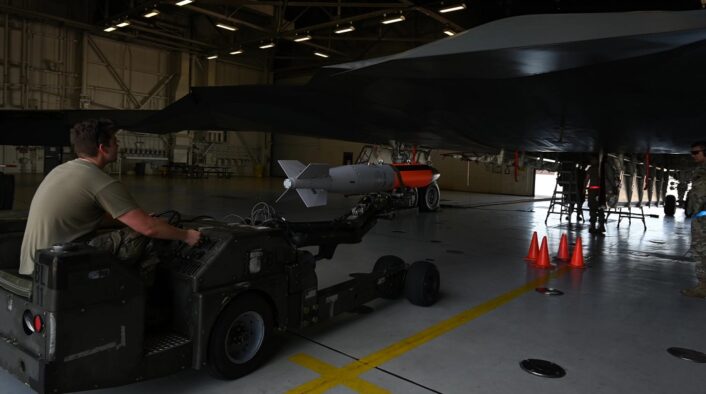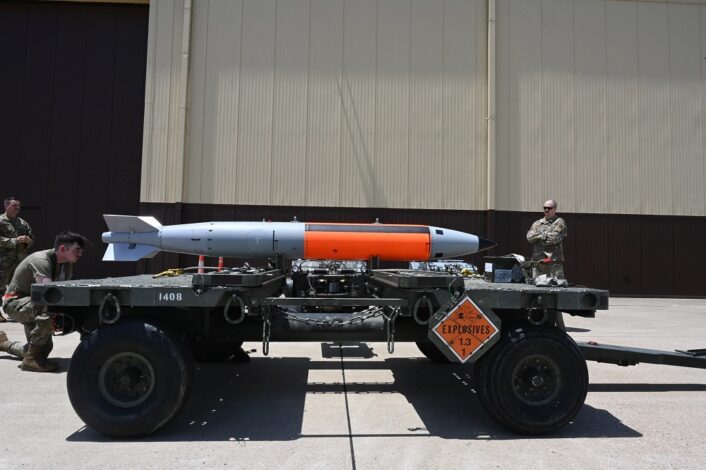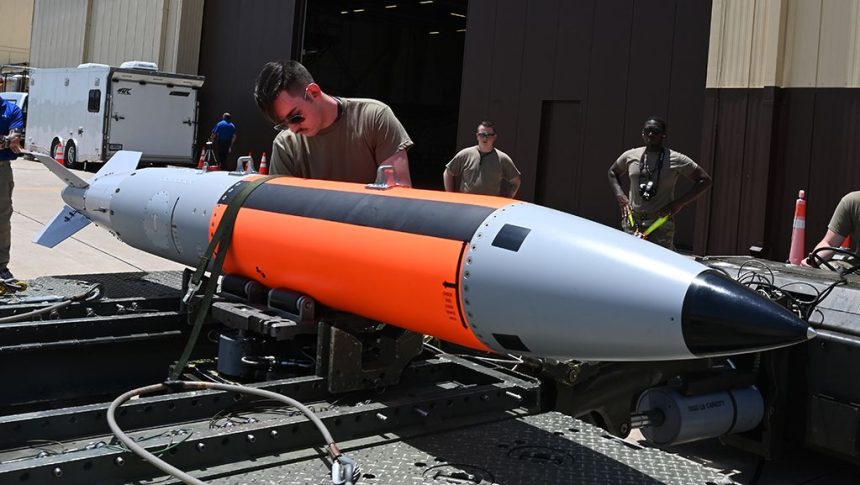The testing of the new nuclear weapon is continuing with the integration on the Spirit stealth bomber.
The U.S. Air Force recently released on the Defense Visual Information Distribution Service (DVIDS) website a series of interesting photos from Whiteman Air Force Base, Missouri. The photos, taken on June 13, 2022, show a high-fidelity, non-nuclear mock B61-12 Joint Test Assembly (JTA) being prepared for test loading inside the B-2A Spirit stealth bomber’s bombs bay. To our knowledge, these should be the first public photos of the weapon with the Spirit since testing aboard the aircraft has begun few years ago.
The Air Force did not provide many details and did not even mention the name of the bomb, simply stating “the 72nd Test and Evaluation Squadron test loads a new nuclear-capable weapons delivery system for the B-2 Spirit bomber”. The 72nd TES, a geographically separated unit of Eglin AFB’s 53rd Wing based at Whiteman, is in charge of all testing and evaluation of new equipment, software and weapons systems for the B-2 Spirit stealth bomber.”
It is not clear what the caption refers to with the term “nuclear-capable weapons delivery system”. The unofficial Nuclear Matters Handbook of the office of the Deputy Assistant Secretary of Defense for Nuclear Matters, gives us the following definition:
“A nuclear weapon delivery system is the military platform and delivery vehicle by which a nuclear weapon is delivered to its intended target in the event of authorized use (by the President of the United States, who retains sole authority to employ nuclear weapons). Most nuclear weapons have been designed for a specific delivery system, making interoperability potentially challenging.
In addition to the mix of silo-based Minuteman III (MMIII) ICBMs, Trident II D5 Life Extension (LE) SLBMs carried on Ohio-class SSBNs, and B-2A and B-52H nuclear-capable heavy bombers, the U.S. nuclear force includes dual-capable aircraft (DCA), that can carry conventional or nuclear weapons.”
Judging by this definition, the weapon delivery system in question should be the B-2A bomber, however the fact that the caption mentions the test loading aboard the aircraft might mean that this system is a new weapon rack inside the bombs bay designed to work with the new B61-12. Available public info states that the Spirit was designed to employ a Bomb Rack Assembly (BRA) for conventional munitions and a Rotary Launcher Assembly (RLA) for the delivery of conventional or nuclear weapons.

The BRA was later upgraded between 2003 and 2006 and became a Smart Bomb Rack Assembly capable of carrying as many as 80 independently targeted, JDAM GPS-guided weapons. So, since the new B61-12 in equipped with a guidance kit, it is possible that also the RLA is now being upgraded to use the new bomb. The new bomb variant will replace the B61-7 and B61-11 currently available for the B-2 fleet.
As we already reported, The B61 entered service 50 years ago and has undergone a Life-Extention Program (LEP) to consolidate and replace four legacy bomb variants, the B61 -3, -4, -7, and -11 mods, into the B61-12. The refurbished B61-12 will allow the retirement of the larger B83, becoming the only remaining gravity delivered nuke in the inventory. The bomb will carry a low-yield nuclear warhead with four yield options, reportedly 0.3 kilotons, 1.5 kilotons, 10 kilotons and 50 kilotons, instead of larger warheads like the models it is replacing (which can reach 400 kilotons depending on the variants).
The 12-foot, 825-pound bomb is designed to be delivered from the air in either ballistic or guided-gravity drop modes, thanks to a new Boeing-built tail assembly that includes an Inertial Navigation System (INS) precision-guidance package and two spin rocket motors that improve the bomb’s stability on its longitudinal axis during the descent. The LEP is said to be increasing the B61’s accuracy so much (with a reported 30 m Circular Error Probability instead of the original 100 m) that it will have the same capability against hardened targets as the much more powerful weapons it is replacing.










